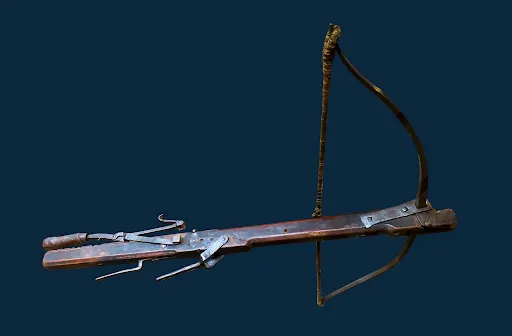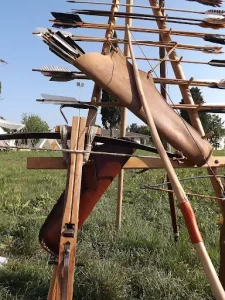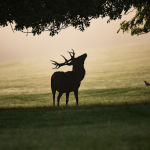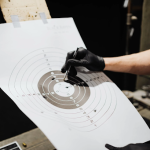
Whether you inherited a vintage crossbow, discovered one on your thrift circuit, or want to add one to your weapons collection, you might have questions about these highly historical items — namely, “What do you do with a vintage crossbow?”
Hunters, historians, and artists can all take advantage of antique crossbows. In some cases, they could be restored (or even fired again on a hunt or at the range). Perhaps a vintage crossbow could add character to your next deer mount. Or, maybe one deserves to hang in that special place above the mantel.
In this guide, we’re exploring ten vintage crossbow ideas to help inspire you. Whether you already have one in your collection or you’re planning to keep your eyes peeled, we’re here to help you make the best of your antique acquisition.
#1 Refurbish One
If you come across a vintage crossbow, perhaps the first thing to consider is whether or not it can be refurbished.
Keep in mind that, even if you restore an antique weapon to its former glory aesthetically speaking, it still might not be safe to fire it in the field. So, depending on your vintage crossbow’s condition, temper your expectations ahead of any restoration projects.
As you refurbish your vintage crossbow, you’ll want to:
- Sand and refinish any wood components
- Polish hardware and mechanisms
- Restore or replace the string
But, remember that antiques can be fragile; opt for gentle cleaning and finishing products (and strings of appropriate tensile strength) when you can to protect the long-term integrity of the piece.
#2 Use a Refurbished Vintage Crossbow on Your Next Hunt
If, after refurbishing, your vintage crossbow is safe to fire, consider taking it with you on your next hunt.
But, before taking any shots (or even transporting it to the field), consider having an archery expert examine and evaluate it for safety purposes. If your crossbow won’t stand up to the demands of firing, don’t risk your safety (or your hunting ethics) in the field.
Speaking of hunting ethics, there are a few extra precautions you should take if you choose to carry a vintage crossbow as your primary weapon on your next hunt:
- Bring a backup weapon (like a modern crossbow or firearm)
- Take conservative, close-range shots
- Only take shots you’re highly confident it will be lethal
#3 Use It for Simulation
Perhaps your vintage crossbow isn’t fireable — you can still use it, just not for firing purposes.
Consider using a vintage crossbow as a simulation tool while teaching children or new crossbow hunters about hunting or weapons safety. Having an actual weapon in their hands (even if it isn’t fireable) can help impart important lessons in a hands-on fashion.
Plus, if your antique is a family heirloom, your experiences teaching your younger relatives about crossbow safety might be especially meaningful.
#4 Use It As an Educational Tool
If your crossbow is in good enough condition to tinker with (but perhaps not to shoot), it could be more than just a simulation tool: it’s an opportunity for your crossbow pupils to become intimately familiar with this type of weapon.
While you should only take this route if your crossbow is in the appropriate condition, you could challenge your hunter-in-training to disassemble and reassemble the weapon until they’re proficient with this process. There are two distinct advantages to this approach:
- They’ll develop an intimate understanding of how the weapon works and how to troubleshoot malfunctions.
- They’re not tinkering with your primary weapon, which may be too valuable to entrust to newcomers.
#5 Incorporate One Into a Mount
If you’re an avid crossbow hunter and you’re considering a full-size mount of a large game animal this season, consider incorporating your vintage crossbow into your mount.
Even if you don’t take down your kill with the weapon in question, it could still add character and unique value to your mount. Or, you could simply hang the crossbow on the wall next to a small mount.
If you’re looking to get creative with mounting your antique crossbow, talk through ideas with your taxidermist before the busy season.
#6 Display It
Speaking of displays, vintage crossbows make excellent visual interest pieces — what better conversation starter could there be than an antique weapon hanging over the fireplace or next to the door?
As you consider potential areas to display your crossbow, remember to think about:
- Cleaning ease – Will it be easy to reach your crossbow, take it down, and dust it in your display location?
- Safety – Even if it’s not fireable, your vintage crossbow shouldn’t be in reach of children, intruders, or other untrustworthy hands.
- Condition – To optimize artistic value, consider refurbishing the crossbow before hanging it up.
#7 Create a Detailed Record and Report
Whether you’re displaying, using, or storing your vintage crossbow, remember that your item has historical value — so, it also offers a research opportunity.
Especially if your antique weapon is particularly old, conducting in-depth research about it and documenting your findings could be a valuable pursuit. Your report could include:
- The names of any known previous owners
- Any stories associated with the weapon (like known hunting kills)
- The year when or the location where it was made
- Any known specifications
- An estimated value of the weapon throughout history
If your vintage crossbow is a family heirloom that you plan to pass along, the research and documentation process could be especially useful — especially for the people inheriting it.
#8 Engrave It
If you plan to give a vintage crossbow as a gift — whether it’s functional or will become a display piece — consider engraving it to add extra sentimental value to the piece.
This is where research could come in handy; if the crossbow in question was an ancestor’s favorite bear hunting weapon, for instance, a bear engraving might imbue special meaning.
Other engraving ideas include:
- The date you plan to give it (or some other significant date)
- The recipient’s name
- The initials of the original owner (if the owner was an ancestor of the recipient, perhaps)
- A symbol meaningful to the recipient, the occasion, or the weapon’s history
#9 Donate It to a Museum
If your vintage crossbow is highly historical — perhaps it’s more than a century old or was used in a historically significant context — it might be best cared for by expert conservators in a museum. If there’s a history museum near you, for instance, you could donate your antique to their collection for display, restoration, research, or safekeeping.
Donating a historical artifact to a museum is certainly something to be proud of. Plus, museum professionals are highly trained to care for and preserve antique items. And, you can return to the museum to see the weapon in its full glory anytime you’d like.
#10 Store It Safely
Some of the ideas above are certainly ambitious — restoring a vintage crossbow might be outside of your area of expertise. There’s certainly nothing wrong with storing your crossbow safely and taking it out to look it over, reminisce, or show it to someone on occasion.
If you choose to store your vintage crossbow, choose storage options that are guaranteed to keep the item:
- Dry
- Out of reach of children
- As dust-free as possible
- Free of mold and mildew
Vintage Crossbows Offer A Wealth of Opportunities

As you can see, there are numerous potential uses for an antique crossbow — whether you choose to display it, use it, or explore its historical value.
Vintage crossbows offer a wealth of opportunities for antique collectors, avid hunters, crossbow newcomers, and more.






